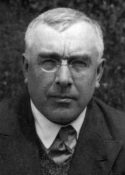
Gurdjieff International Review
Ouspensky
by Christopher Fremantle
Russian author, mathematician and mystic, Peter Demianovich Ouspensky was born in Moscow in 1878. His philosophic and speculative writings Tertium Organum and A New Model of the Universe were bestsellers in the United States in the 1920s, but he is chiefly known for his lucid account of the teaching of G. I. Gurdjieff, published posthumously with the subject’s consent under the title In Search of the Miraculous.
A short stocky man with grey-blue eyes and pince-nez spectacles, Ouspensky was an outstanding lecturer on account of his penetrating thought and challenging approach. His father, Demian Petrovich Ouspensky, was an army officer and his mother was a painter. Of precocious intelligence, after reading Lermontov and Turgenev, at the age of six he became interested in poetry and painting; at 13 his interest turned to dreams and consequently to psychology; by 18 he had begun to travel and write. He continued studying intensively biology, mathematics and psychology. He relates: ‘I was very anarchistically inclined at that time. I particularly distrusted all forms of academic science and took a firm decision never to pass any examinations and never to take any degrees.’
Ouspensky’s first book was Kinemadrama, a novel on the theme of eternal recurrence. In 1907 he discovered theosophical literature, then prohibited in Russia, and ‘found a possible angle for the study of religion and mysticism and received a new impulse for the study of “higher dimensions.”’ The publication in 1909 of The Fourth Dimension placed him in the front rank of writers on abstract mathematical theory.
The same year, at the age of 31, he moved from Moscow to St. Petersburg (Leningrad) where he published several books including Superman, What is Yoga? and, in 1912, Tertium Organum. This book deeply questioned the whole philosophic foundation of the scientific thinking of the day concerning space, time and relativity; it endeavoured to reconcile Western logical thought with Eastern mysticism. A year later, in 1913, a short work on The Symbolism of the Tarot was published.
Ouspensky then began to travel extensively in search of a contact with Eastern traditional and esoteric schools. In 1913–14 he went to Egypt and continued to Ceylon and India, returning to England shortly after the outbreak of the First World War. A notable series of lectures on his travels and ‘search for the miraculous,’ given in 1915 in St. Petersburg, attracted large audiences and a rapidly growing following in Russian intellectual circles. Among this audience was Sophia Grigorievna Maximenko, whom he married two years later.
In 1915 Ouspensky met George Ivanovich Gurdjieff, an event which marked a turning point in his life. Gurdjieff’s ideas profoundly impressed him; he recognized that Gurdjieff had discovered in the East many things for which he himself had searched. ‘I realized,’ he wrote, ‘that I had met with a completely new system of thought surpassing all I knew before. This system threw quite a new light on psychology and explained what I could not understand before in esoteric ideas.’ Ouspensky began to form special study groups in St. Petersburg which Gurdjieff visited regularly. From that moment until Ouspensky’s death the study and practical development of Gurdjieff’s ideas constituted his principal aim.
These activities were interrupted at the end of 1916 when Ouspensky obtained a commission in the army but he was honourably discharged after only four months on account of poor eyesight, two weeks before the Revolution broke out. Seeing then no hope of continuing his work in Russia, he decided to emigrate to London.
Ouspensky rejoined Gurdjieff, who had already left Moscow, in Alexandropol in June 1917; in July with several friends from the Moscow and St. Petersburg groups they moved to Essentuki and then to Tuapse on the Black Sea. In the autumn of 1917 Ouspensky paid a last visit to St. Petersburg to rescue what he could of notes and manuscripts, leaving a bare week before the Bolsheviks overthrew the provisional government.
The year 1918 was spent in the company of Gurdjieff on the Black Sea; but that winter Ouspensky returned to Essentuki. He only succeeded in reaching Constantinople (Istanbul), crowded with Russians, in January 1920. There he wrote and lectured on psychology and his travels. That summer he again met Gurdjieff, arrived by way of Tiflis in company with some of their friends. In 1921, still without the means to reach England, Ouspensky unexpectedly received an invitation to visit London from Viscountess Rothermere, who wished to meet the author of Tertium Organum, which had aroused considerable interest on its publication in English.
Reaching London in August, Ouspensky found himself in contact with influential people who became interested in his work. In 1924 he broke with Gurdjieff and decided to continue his work in England, independently.
From 1924 until 1940 Ouspensky wrote and lectured in London, and held study groups—to investigate Gurdjieff’s ideas—which were attended by many well-known people. He completed A New Model of the Universe incorporating revisions of several previous works and wrote a detailed account of his years with Gurdjieff, In Search of the Miraculous.
At the outbreak of the Second World War Ouspensky moved to New York to continue lectures, discussions and work on Gurdjieff’s ideas and on his own last book. Publication of Kinemadrama in English, entitled The Strange Life of Ivan Osokin, was arranged. Early in 1947 Ouspensky, accompanied by a few pupils, returned to England; he died there later in the same year.
~ • ~
First published in Man, Myth and Magic: An Illustrated Encyclopedia of the Supernatural, 1972, 1982, 1995.
|
This webpage © 2000 Gurdjieff Electronic Publishing Featured: Fall 2000 Issue, Vol. IV (1) Revision: December 1, 2003 |